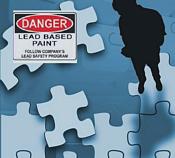RRP Training Refresher: Defining Work Area Containment
It’s probably been a while since you took your RRP Certified Renovator Training Class. This blog post is offered as a refresher topic to help you keep important details about the RRP rule top of mind when selling, estimating or performing RRP renovations.
Refresher: Defining Work Area Containment
What is Containment?

“Containment” is what is required under the RRP Rule to prevent dust and debris from spreading beyond the work area to non-work areas. In general, there are many degrees of containment, ranging from simple plastic sheeting on the floor surrounding a small work area to a fully enclosed space. Some types of containment are more effective than other types.
Why is Containment Required?
 Containment is required by the RRP Rule because it reduces the risk to you and residents. Following the work area setup requirements will protect you, your co-workers and residents by confining lead-contained dust and debris to a defined and demarcated area. Confining the lead is an important consideration in avoiding exposure. Reducing the risk to you and co-workers is also dependent upon use of personal protective equipment. Requirements for the personal protection of workers are established by OSHA and can be found in the OSHA document titled “Lead in Construction”
Containment is required by the RRP Rule because it reduces the risk to you and residents. Following the work area setup requirements will protect you, your co-workers and residents by confining lead-contained dust and debris to a defined and demarcated area. Confining the lead is an important consideration in avoiding exposure. Reducing the risk to you and co-workers is also dependent upon use of personal protective equipment. Requirements for the personal protection of workers are established by OSHA and can be found in the OSHA document titled “Lead in Construction”
 Proper containment also facilitates efficient cleaning of the work area. The pre-work setup process is essential to keeping lead-contaminated dust confined to the work area where it can be easily cleaned. Proper containment of the work area helps to limit the area you need to clean after the job is complete. Knowing exactly where to clean is an important factor in saving time (and money) spent on cleanup.
Proper containment also facilitates efficient cleaning of the work area. The pre-work setup process is essential to keeping lead-contaminated dust confined to the work area where it can be easily cleaned. Proper containment of the work area helps to limit the area you need to clean after the job is complete. Knowing exactly where to clean is an important factor in saving time (and money) spent on cleanup.
Controlling dust and debris may require more extensive containment than is specified in the rule if the job is particularly dusty. For example, small areas of ceiling work can spread dust over the entire room and are very difficult to control.
Containing the Work Area Includes:
- Removing objects and furniture from the work area, or covering them with plastic sheeting.
 Covering floors (or the ground) with plastic sheeting a minimum distance beyond the surfaces being renovated (6 feet for interior jobs and 10 feet for exterior jobs).
Covering floors (or the ground) with plastic sheeting a minimum distance beyond the surfaces being renovated (6 feet for interior jobs and 10 feet for exterior jobs).- Vertical containment is required for any exterior renovation within 10 feet of the property line.
- Larger areas of disposable plastic sheeting may also be necessary to prevent the spread of dust.
- Smaller areas of containment may be used if additional precautions such as vertical containment are used to stop the spread of dust and minimize the area of cleanup.
- Closing windows and doors, and using plastic sheeting to seal doors and air ducts in the work area.
- Covering doors used to enter the work area with plastic sheeting in a manner that allows workers to pass through but contains dust and debris within the work area.

 Looking for accurate information about the EPA RRP rule?
Looking for accurate information about the EPA RRP rule? 



